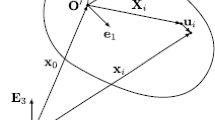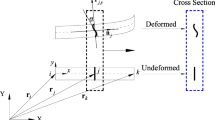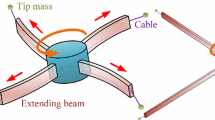Abstract
The reliability and dynamic performance of deployable flexible space structures significantly depend on their key design parameters. Sensitivity analysis of these design parameters in the frame of multibody dynamics can serve as a powerful tool to evaluate and improve the dynamic performances of deployable space structures. Nevertheless, previous studies on the sensitivity analysis are mainly confined to planar multibody systems with a few design parameters. In this study, an efficient computational methodology is proposed to perform the sensitivity analysis of the complex deployable space structures with a large number of design parameters. Firstly, the analytical sensitivity analysis formulations of objective functions with the parameter-dependent integration bounds are deduced via the direct differentiation method and adjoint variable method. A checkpointing scheme is further introduced to assist the backward integration of the high-dimensional differential algebraic equations of the adjoint variables. The flexible beams in the deployable flexible space structure are described by the locking-free three-node spatial beam elements of absolute nodal coordinate formulation. Furthermore, a parallelized automatic differentiation algorithm is proposed to efficiently evaluate the complex partial derivatives in the sensitivity analysis formulations. Finally, four numerical examples are provided to validate the accuracy and efficiency of the proposed computational methodology.

















Similar content being viewed by others
Availability of data and materials
The datasets generated during the current study are available from the corresponding author on reasonable request.
References
Mitsugi, J., Ando, K., Senbokuya, Y., Meguro, A.: Deployment analysis of large space antenna using flexible multibody dynamics simulation. Acta Astronaut. 47, 19–26 (2000)
Li, P., Liu, C., Tian, Q., Hu, H., Song, Y.: Dynamics of a deployable mesh reflector of satellite antenna: parallel computation and deployment simulation1. J. Comput. Nonlinear Dyn. 11, 061005 (2016)
Peng, Y., Zhao, Z., Zhou, M., He, J., Yang, J., Xiao, Y.: Flexible multibody model and the dynamics of the deployment of mesh antennas. J. Guid. Control Dyn. 40, 1499–1510 (2017)
Li, K., Tian, Q., Shi, J., Liu, D.: Assembly dynamics of a large space modular satellite antenna. Mech. Mach. Theory. 142, 103601 (2019)
Dopico, D., Sandu, A., Sandu, C., Zhu, Y.T.: Sensitivity analysis of multibody dynamic systems modeled by ODEs and DAEs. In: Proceedings of the ECCOMAS Thematic Conference on Multibody Dynamics. pp. 1–32. Zagreb, Croatia (2014)
Dopico, D., González, F., Luaces, A., Saura, M., García-Vallejo, D.: Direct sensitivity analysis of multibody systems with holonomic and nonholonomic constraints via an index-3 augmented Lagrangian formulation with projections. Nonlinear Dyn. 93, 2039–2056 (2018)
Dopico, D., Zhu, Y., Sandu, A., Sandu, C.: Direct and adjoint sensitivity analysis of ordinary differential equation multibody formulations. J. Comput. Nonlinear Dyn. 10, 011012 (2015)
Bhalerao, K.D., Poursina, M., Anderson, K.S.: An efficient direct differentiation approach for sensitivity analysis of flexible multibody systems. Multibody Syst. Dyn. 23, 121–140 (2010)
Neto, M.A., Ambrósio, J.A.C., Leal, R.P.: Sensitivity analysis of flexible multibody systems using composite materials components. Int. J. Numer. Methods Eng. 77, 386–413 (2009)
Xiang, W., Yan, S., Wu, J., Niu, W.: Dynamic response and sensitivity analysis for mechanical systems with clearance joints and parameter uncertainties using Chebyshev polynomials method. Mech. Syst. Signal Process. 138, 106596 (2020)
Tromme, E., Brüls, O., Emonds-Alt, J., Bruyneel, M., Virlez, G., Duysinx, P.: Discussion on the optimization problem formulation of flexible components in multibody systems. Struct. Multidiscip. Optim. 48, 1189–1206 (2013)
Ebrahimi, M., Butscher, A., Cheong, H., Iorio, F.: Design optimization of dynamic flexible multibody systems using the discrete adjoint variable method. Comput. Struct. 213, 82–99 (2019)
Zhang, M., Peng, H., Song, N.: Semi-analytical sensitivity analysis approach for fully coupled optimization of flexible multibody systems. Mech. Mach. Theory. 159, 104256 (2021)
Shourijeh, M.S.: Optimal Control and Multibody Dynamic Modelling of Human Musculoskeletal Systems. Ph.D. thesis, University of Waterloo (2013)
Serban, R., Freeman, J.S.: Identification and identifiability of unknown parameters in multibody dynamic systems. Multibody Syst. Dyn. 5, 335–350 (2001)
Ebrahimi, S., Kövecses, J.: Sensitivity analysis for estimation of inertial parameters of multibody mechanical systems. Mech. Syst. Signal Process. 24, 19–28 (2010)
Burden, R.L., Faires, J.D.: Numerical Analysis. Brooks/Cole, Cengage Learning, Boston (2011)
Schaffer, A.S.: On the adjoint formulation of design sensitivity analysis of multibody dynamics. Ph.D. thesis, University of Iowa (2005)
Laflin, J.J., Anderson, K.S., Khan, I.M., Poursina, M.: Advances in the application of the divide-and-conquer algorithm to multibody system dynamics. J. Comput. Nonlinear Dyn. 9, 041003 (2014)
Callejo, A., Dopico, D.: Direct sensitivity analysis of multibody systems: a vehicle dynamics benchmark. J. Comput. Nonlinear Dyn. 14, 021004 (2019)
Nachbagauer, K., Oberpeilsteiner, S., Sherif, K., Steiner, W.: The use of the adjoint method for solving typical optimization problems in multibody dynamics. J. Comput. Nonlinear Dyn. 10, 061011 (2015)
Lauß, T., Oberpeilsteiner, S., Steiner, W., Nachbagauer, K.: The discrete adjoint gradient computation for optimization problems in multibody dynamics. J. Comput. Nonlinear Dyn. 12, 031016 (2017)
Serban, R., Hindmarsh, A.C.: CVODES: The Sensitivity-Enabled ODE Solver in SUNDIALS. In: Volume 6: 5th International Conference on Multibody Systems, Nonlinear Dynamics, and Control, Parts A, B, and C. pp. 257–269. ASMEDC, Long Beach, California, USA (2005)
Hindmarsh, A.C., Brown, P.N., Grant, K.E., Lee, S.L., Serban, R., Shumaker, D.E., Woodward, C.S.: SUNDIALS: Suite of nonlinear and differential/algebraic equation solvers. ACM Trans. Math. Softw. 31, 363–396 (2005)
Sirkes, Z., Tziperman, E.: Finite difference of adjoint or adjoint of finite difference? Mon. Weather Rev. 125, 6 (1997)
Pi, T., Zhang, Y., Chen, L.: First order sensitivity analysis of flexible multibody systems using absolute nodal coordinate formulation. Multibody Syst. Dyn. 27, 153–171 (2012)
Bauchau, O.A., Han, S., Mikkola, A., Matikainen, M.K., Gruber, P.: Experimental validation of flexible multibody dynamics beam formulations. Multibody Syst. Dyn. 34, 373–389 (2015)
Serban, R., Recuero, A.: Sensitivity analysis for hybrid systems and systems with memory. J. Comput. Nonlinear Dyn. 14, 091006 (2019)
Corner, S., Sandu, C., Sandu, A.: Adjoint sensitivity analysis of hybrid multibody dynamical systems. Multibody Syst. Dyn. 49, 395–420 (2020)
Sonneville, V., Brüls, O.: Sensitivity analysis for multibody systems formulated on a Lie group. Multibody Syst. Dyn. 31, 47–67 (2014)
Lauß, T., Oberpeilsteiner, S., Steiner, W., Nachbagauer, K.: The discrete adjoint method for parameter identification in multibody system dynamics. Multibody Syst. Dyn. 42, 397–410 (2018)
Azari Nejat, A., Moghadasi, A., Held, A.: Adjoint sensitivity analysis of flexible multibody systems in differential-algebraic form. Comput. Struct. 228, 106148 (2020)
Wang, Q., Yu, W.: Sensitivity Analysis of Geometrically Exact Beam Theory (GEBT) Using the Adjoint Method with Hydra. In: 52nd AIAA/ASME/ASCE/AHS/ASC Structures, Structural Dynamics and Materials Conference. American Institute of Aeronautics and Astronautics, Denver, Colorado (2011)
Gutiérrez-López, M.D., Callejo, A., de Jalón, J.G.: Computation of independent sensitivities using Maggi’s formulation. In: Proceedings of the 2nd Joint International Conference on Multibody System Dynamics, Stuttgart, Germany (2012)
Shabana, A.A., Xu, L.: Rotation-based finite elements: reference-configuration geometry and motion description. Acta Mech. Sin. 37, 105–126 (2021)
Martins, J.R.R.A., Hwang, J.T.: Review and unification of methods for computing derivatives of multidisciplinary computational models. AIAA J. 51, 2582–2599 (2013)
Baydin, A.G., Pearlmutter, B.A., Radul, A.A., Siskind, J.M.: Automatic differentiation in machine learning: a survey. J. Mach. Learn. Res. 18, 5595–5637 (2017)
Griewank, A., Walther, A.: Evaluating derivatives: principles and techniques of algorithmic differentiation. Society for Industrial and Applied Mathematics, Philadelphia, PA (2008)
Yu, W., Blair, M.: DNAD, a simple tool for automatic differentiation of fortran codes using dual numbers. Comput. Phys. Commun. 184, 1446–1452 (2013)
Straka, C.W.: ADF95: Tool for automatic differentiation of a FORTRAN code designed for large numbers of independent variables. Comput. Phys. Commun. 168, 123–139 (2005)
Stamatiadis, S., Prosmiti, R., Farantos, S.C.: AUTO_DERIV: tool for automatic differentiation of a FORTRAN code. Comput. Phys. Commun. 127, 343–355 (2000)
Bischof, C., Khademi, P., Mauer, A., Carle, A.: Adifor 2.0: automatic differentiation of Fortran 77 programs. IEEE Comput. Sci. Eng. 3, 18–32 (1996)
Utke, J., Aachen, T.H., Fagan, M., Tallent, N., Strout, M., Hill, P.H.C., Fagan, M., Tallent, N., Univer, R.: OpenAD/F: a modular, open-source tool for automatic differentiation of Fortran codes. ACM Trans Math Softw. 34, 1–36 (2008)
Callejo, A., Narayanan, S.H.K., García de Jalón, J., Norris, B.: Performance of automatic differentiation tools in the dynamic simulation of multibody systems. Adv. Eng. Softw. 73, 35–44 (2014)
Kudruss, M., Manns, P., Kirches, C.: Efficient derivative evaluation for rigid-body dynamics based on recursive algorithms subject to kinematic and loop constraints. IEEE Control Syst. Lett. 3, 619–624 (2019)
Hoffait, S., Brüls, O., Granville, D., Cugnon, F., Kerschen, G.: Dynamic analysis of the self-locking phenomenon in tape-spring hinges. Acta Astronaut. 66, 1125–1132 (2010)
Newmark, N.M.: A method of computation for structural dynamics. J. Eng. Mech. Div. 85, 67–94 (1959)
Boopathy, K., Kennedy, G.J.: Parallel finite element framework for rotorcraft multibody dynamics and discrete adjoint sensitivities. AIAA J. 57, 3159–3172 (2019)
Gavrea, B., Negrut, D., Potra, F.A.: The Newmark Integration Method for Simulation of Multibody Systems: Analytical Considerations. In: Design Engineering, Parts A and B. pp. 1079–1092. ASMEDC, Orlando, Florida, USA (2005)
Nachbagauer, K., Gruber, P., Gerstmayr, J.: Structural and Continuum mechanics approaches for a 3D shear deformable ANCF beam finite element: application to static and linearized dynamic examples. J. Comput. Nonlinear Dyn. 8, 0004 (2013)
Gerstmayr, J., Shabana, A.A.: Efficient integration of the elastic forces and thin three-dimensional beam elements in the absolute nodal coordinate formulation. In: ECCOMAS Thematic Conference, Madrid, Spain, 21–24 June (2005)
Tang, Y., Hu, H., Tian, Q.: A condensed algorithm for adaptive component mode synthesis of viscoelastic flexible multibody dynamics. Int. J. Numer. Methods Eng. 122, 609–637 (2021)
Lan, P., Tian, Q., Yu, Z.: A new absolute nodal coordinate formulation beam element with multilayer circular cross section. Acta Mech. Sin. 36, 82–96 (2020)
Maqueda, L.G., Shabana, A.A.: Poisson modes and general nonlinear constitutive models in the large displacement analysis of beams. Multibody Syst. Dyn. 18, 375–396 (2007)
Shabana, A.A.: ANCF reference node for multibody system analysis. Proc. Inst. Mech. Eng. Part K J. Multi-Body Dyn. 229, 109–112 (2015)
Acknowledgements
This research was supported in part by the National Natural Science Foundations of China under Grants 11722216 and 11832005. The research was also supported in part by the 111 China Project (B16003). This work was supported in part by the project from the Beijing Institute of Technology-Shanghai Academy of Spaceflight Technology joint laboratory.
Author information
Authors and Affiliations
Corresponding author
Ethics declarations
Conflict of interest
The authors declare that they have no conflict of interest.
Additional information
Publisher's Note
Springer Nature remains neutral with regard to jurisdictional claims in published maps and institutional affiliations.
Rights and permissions
About this article
Cite this article
Wang, S., Tian, Q., Hu, H. et al. Sensitivity analysis of deployable flexible space structures with a large number of design parameters. Nonlinear Dyn 105, 2055–2079 (2021). https://doi.org/10.1007/s11071-021-06741-4
Received:
Accepted:
Published:
Issue Date:
DOI: https://doi.org/10.1007/s11071-021-06741-4




